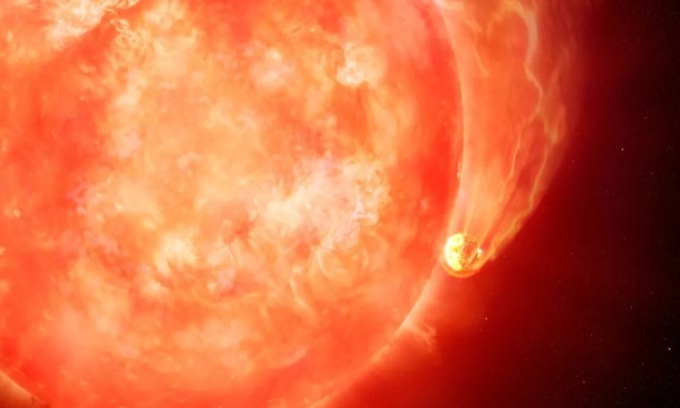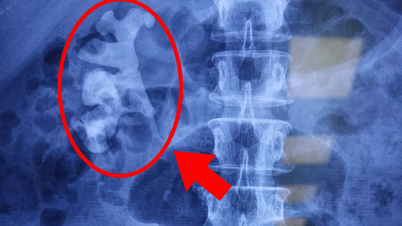Astronomers have witnessed a Sun-like star swallowing a planet, revealing the fate of Earth in about 4-5 billion years when the Sun expands.

Simulation of a dying star devouring an exoplanet. Photo: NOIRLab/NSF/AURA
By analyzing countless stars at various stages of evolution, astronomers have discovered that as the Sun and similar stars near the end of their lives, they begin to exhaust their basic fuel source of hydrogen near their cores, causing the core to contract while the outer shell expands and cools. During this “red giant” phase, the star swells to 100 to 1,000 times its original diameter, engulfing the planets orbiting it.
For decades, scientists have found evidence of stars before and after they devour planets. But they have never seen one so active. In a new study published May 3 in the journal Nature, Kishalay De , an astrophysicist at the Massachusetts Institute of Technology, and his colleagues examined a burst of light called ZTF SLRN-2020, which was recorded in 2020 in the disk of the Milky Way, 12,000 light-years away, near the constellation Aquila. During the event, a star brightened 100 times over the course of a week.
The team made their initial discovery by analyzing data collected by the Zwicky Transient Facility at the California Institute of Technology's Palomar Observatory. The Zwicky Transient Facility scans the sky for stars that rapidly change in brightness. To learn more about ZTF SLRN-2020, De analyzed the spectrum of light from the flare.
Cold gas from such a flash is usually the result of a stellar merger. When De looked deeper into data from the same star collected by the Keck Observatory in Hawaii, he found that the molecules only exist at very cold temperatures. Cold gas can condense to form dust over time. About a year after the initial discovery, De and his colleagues analyzed data from the star taken from an infrared camera at the Palomar Observatory. Infrared data can reveal signals from even colder matter. The scientists found that the burst of visible light from the star was accompanied by a near-infrared signal that faded after six months.
Finally, the team examined data collected by NASA’s NEOWISE infrared space telescope. The results showed that the total energy released by the star after the initial flare was very small. That means the object that merged with the star must have been 1,000 times smaller than any other star. Jupiter’s mass is also about 1/1,000th the mass of the Sun. From that, the researchers concluded that it was a planet crashing into its host star.
Based on the nature of the flare, astronomers estimate that the event released hydrogen equivalent to 33 Earth masses and dust equivalent to 0.33 Earth masses. From this, they calculate that the host star was 0.8 to 1.5 solar masses and engulfed a planet between 1 and 10 Jupiter masses. Earth is expected to suffer a similar fate when the Sun becomes a red giant in about 5 billion years.
An Khang (According to Space )
Source link



![[Photo] General Secretary To Lam receives Chief of the Central Office of the Lao People's Revolutionary Party](https://vphoto.vietnam.vn/thumb/1200x675/vietnam/resource/IMAGE/2025/5/30/140435f4b39d4599a3d17975dfb444c5)
![[Photo] A delegation of 100 journalists from the Vietnam Journalists Association visits the soldiers and people of Truong Sa island district.](https://vphoto.vietnam.vn/thumb/1200x675/vietnam/resource/IMAGE/2025/5/30/0984a986227d4e988177f560d2e1563e)
![[Photo] National Conference "100 years of Vietnamese Revolutionary Press accompanying the glorious cause of the Party and the nation"](https://vphoto.vietnam.vn/thumb/1200x675/vietnam/resource/IMAGE/2025/5/30/1cf6cd5c8a934ebfa347028dcb08358c)

![[Photo] Journalists moved to tears at the Memorial Service for the soldiers who died in Gac Ma](https://vphoto.vietnam.vn/thumb/1200x675/vietnam/resource/IMAGE/2025/5/30/9454613a55c54c16bf8c0efa51883456)



















































































Comment (0)